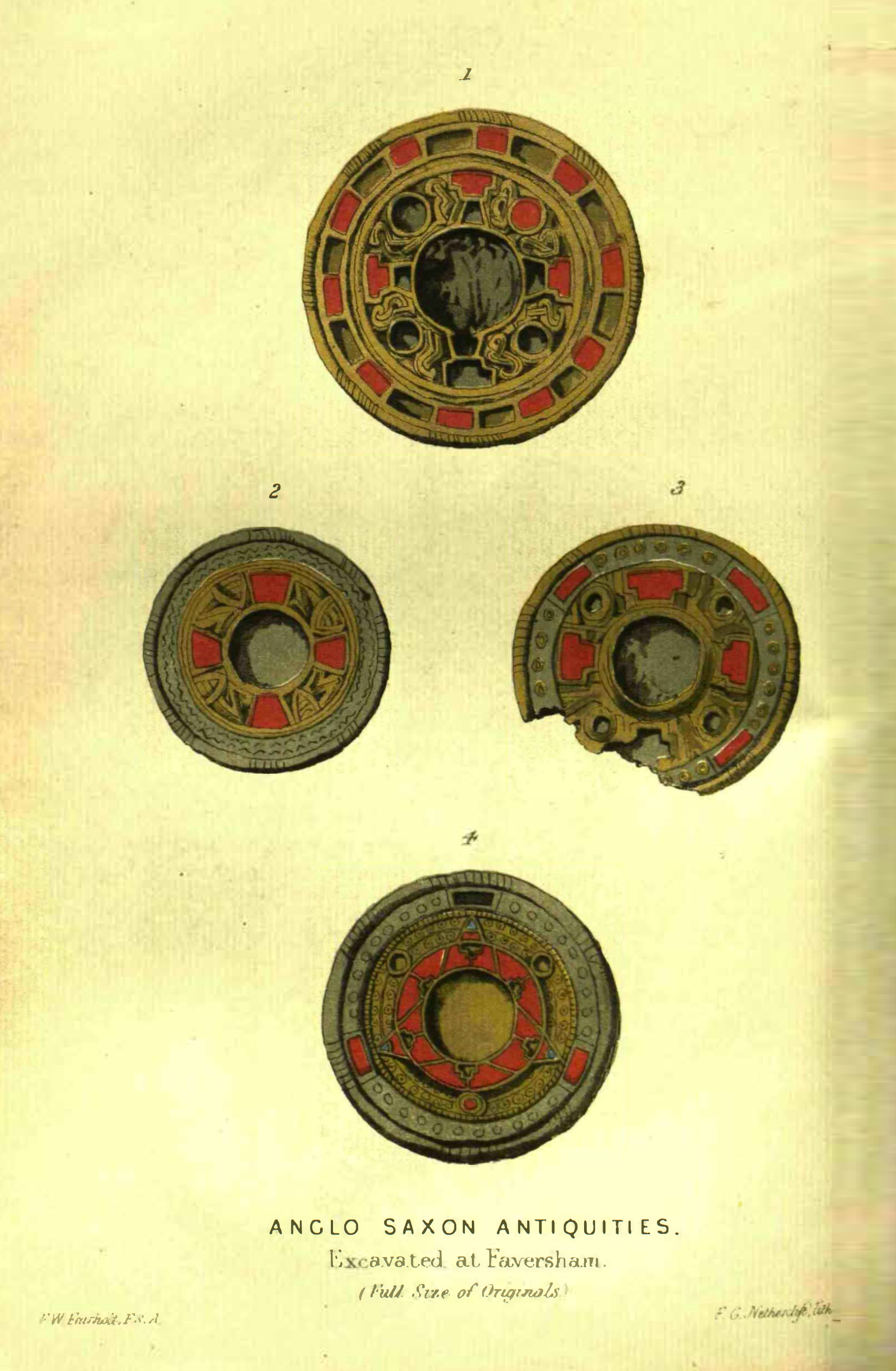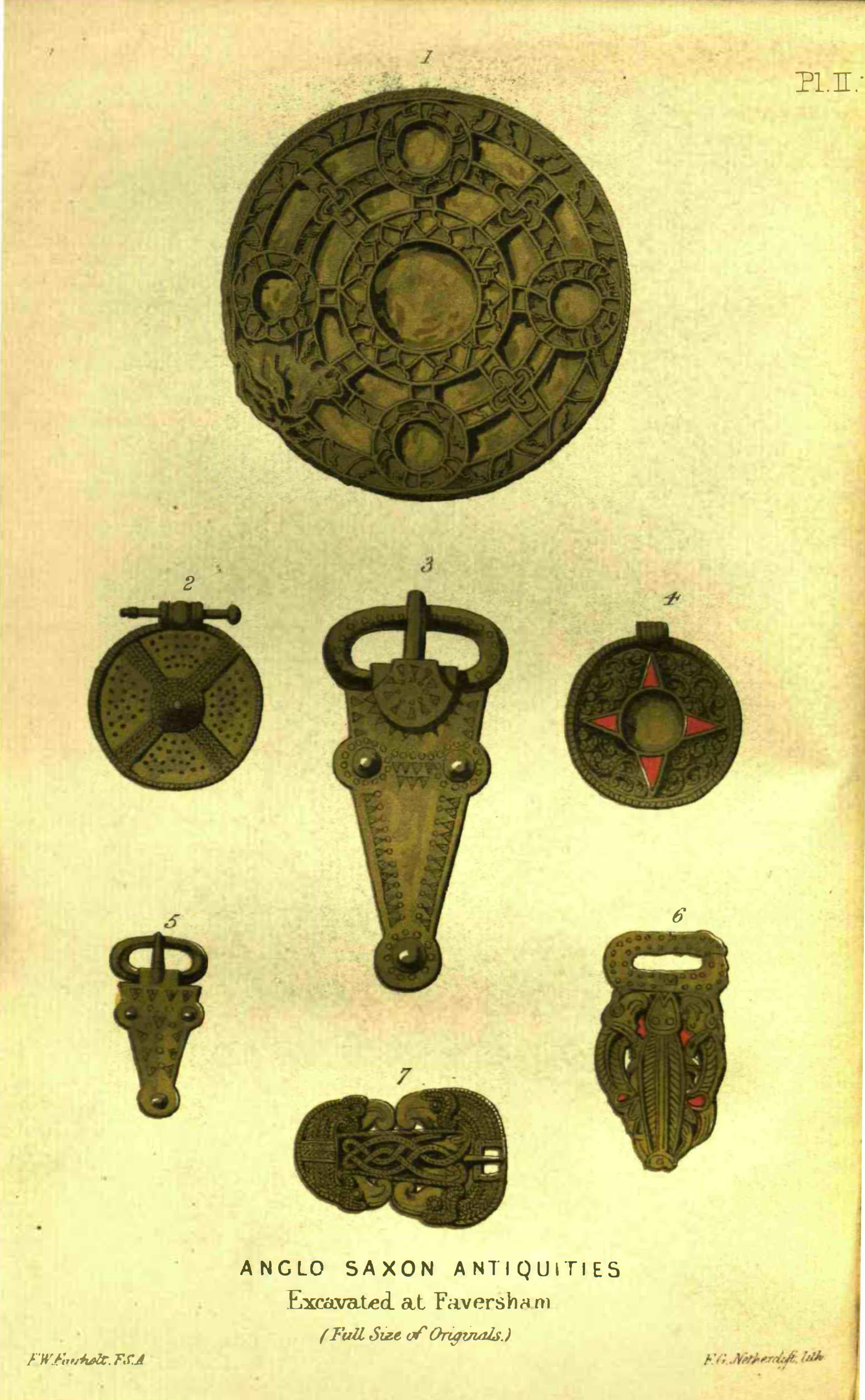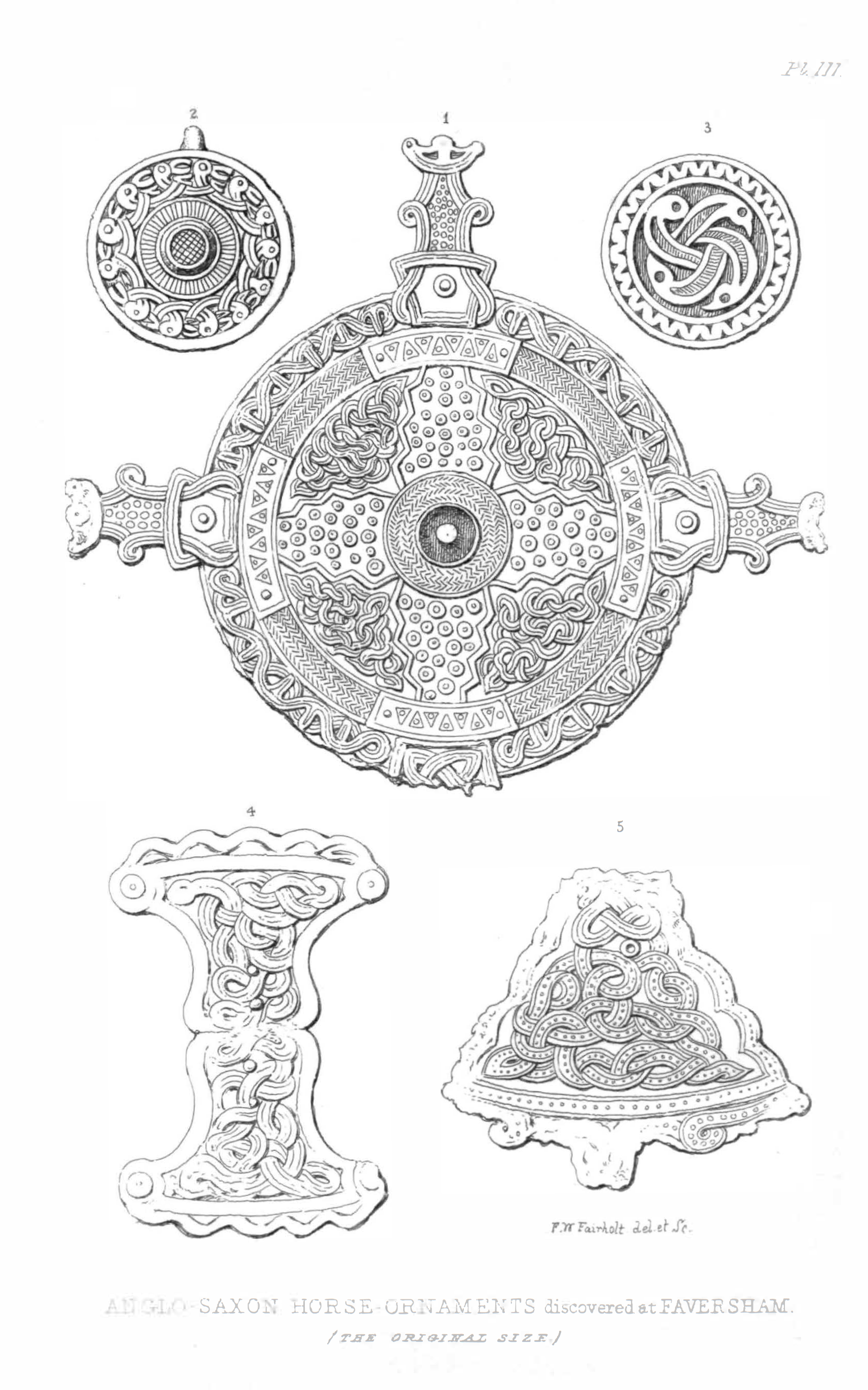On Anglo-Saxon Remains Recently Discovered at Faversham, at Wye and Westwell in Kent
IN A LETTER FROM ROACH SMITH, ESQ., TO THE HONORARY SECRETARY.
[Read at the Meeting at Canterbury]
MY DEAR SIR,
In no branch of archaeology has greater or sounder progress been made than in that which comprises the Saxon antiquities of this country, and the Frankish antiquities of the Continent. Contemporaneous in date, closely analogous in general character, belonging to peoples descended from a common parentage, they are mutually illustrative, and throw a strong and unsuspected light upon the conditions of our ancestors, at a period when historical information is particularly meagre and obscure. And yet, until within the last twenty or thirty years, these monuments of the grave, so authentic and expressive, were but little understood. The researches of Douglas in Kent, well published and illustrated, failed in enlisting followers from among his contemporaries; and the excavations of Bryan Faussett, although they were partially brought under the observation and criticism of Douglas, remained unpublished and but little known. Our neighbours in France and Germany were even more slow to recognize and appreciate this class of their more remote national antiquities; and while Celtic, Roman, and Medieval remains were zealously investigated, the Teutonic were entirely overlooked. Now, however, they occupy their proper position in archaeological studies; and on the Continent, as well as in England, their importance is acknowledged and appreciated by all educated persons who possess any feeling for the history of their native country.
I will not, on the present occasion, enter upon a review of the errors of past times in reference to the Saxon antiquities of our island, nor trace the progress of that process of careful comparison by which we have been enabled to correct mistakes, to place the study upon a firm and rational footing, and assist inquiry by accumulated facts. In the present stage of research, to avoid retrogression, it will be sufficient for me to refer to the works in which the subject has been fully discussed, and accompanied by those illustrations which are so indispensable in studies of this peculiar kind; and I shall limit my remarks to the additional materials which have been discovered, during the present year, at Faversham, at Wye, and at Westwell; and (thanks to the exertions of Mr. Gibbs, Mr. Thurston, and yourself) have been saved from the disastrous fate which, in so many instances, has befallen similar remains.
We learn from the historian Bede, that shortly after the Romans finally departed from Britain, three different tribes of the Teutonic race, at intervals, settled in the island. These were the Jutes, who occupied Kent and the Isle of Wight; the Saxons, forming the divisions known as the East Saxons, the Middle Saxons, the South Saxons, and the West Saxons; and the Angles, who established themselves in extensive portions of the east, the west, and the north: the East Angles, the Mercians, and Northumbrians. That the historian's statement is correct in the main, dialects, physiognomy, the names of places, and other remarkable peculiarities seem to certify, as well as the circumstances under which the various branches of the Teutonic race found themselves placed at the period of the decadence and fall of the Roman power in Britain. It will be extremely interesting if the remains in the graves of the different districts should be found confirming our belief in the information given us by Bede. Up to the present time our researches certainly seem to support the historian's statement. The beautiful circular fibulae from Faversham, as well as the pendent ornaments, are common in the Saxon cemeteries in Kent, while they are of rare occurrence in those of other parts of England. I need only refer you to the discoveries made at the sites explored by Douglas and Bryan Faussett, at the cemeteries at Osengal, Stowting, Sittingbourne, Minster in Thanet, at Maidstone, and in other localities; and then direct comparison with the contents of Saxon cemeteries in Cambridgeshire, in Suffolk, in Norfolk, in Northampton, and in the west of England, to ensure conviction of the marked difference which exists in these ornaments. The circular fibulae of Kent are seldom met with in the districts mentioned above; but others, of baser material and of different forms and decoration, prevail. The same distinction in other sepulchral objects is almost equally marked; while at the same time, in the weapons and umboes of shields, and in other particulars, as well as in the general mode of sepulture, there is a striking accordance, such as would be expected in tribes springing from a common source. The contents of the graves in the Saxon cemetery at Chessell, in the Isle of Wight (which island Bede states was peopled, as well as Kent, by the Jutes), have some striking points of resemblance to those of the graves of Kent, such as seem to be common only to these two districts.
Although, unfortunately, the circumstances under which the Faversham antiquities were obtained, deprive them of the advantage accompanying such as are taken from graves carefully excavated, they are nevertheless of great value to the archaeologist, who, from comparison, will be able to classify most of them. In the plates of Faussett's 'Inventorium Sepulchrale' will be found most of the types of the ornaments, of the weapons, and of those miscellaneous objects which it was the custom of our Saxon forefathers to deposit with the dead. The largest gold fibula, of which the framework only remains, is of the same class as the superb perfect example from Kingston-down, figured in plate i. In its incomplete condition it is useful as showing the manner in which the cells were constructed previous to their being filled with pastes and coloured stones. Some of the pendants, fibulae, and buckles supply us with new varieties; and from their elegant design, good workmanship, and rich material, strengthen our convictions of the superior wealth and refinement of the Kentish Saxons; and show how much they had profited by Roman art and artists.
The most novel feature in Mr. Gibbs's collection, and to which I direct your especial attention, is the fine ornamented plates, with rings and other appendages: they appear to have decorated the harness of a sumptuously caparisoned horse, which there is every reason to suppose was interred with the body of its master, doubtless a thane of distinction. Before the ancient Germans had been much influenced by intercourse with the Romans, and when cremation was more generally practised, we find that burning the war-horse was occasionally one of their funeral ceremonies. Tacitus observes, "sua cuique arma, quorundam igni et equus adjicitur;" and the practice was continued down to a late period: traces of it indeed remain to the present day. Of course only persons of wealth or eminence could afford to make such a costly sacrifice.
The glass vessels comprise the more ordinary varieties which are found in Saxon graves. Rare as they are now become, they must have been in general use among the Saxons, although, from the fragile nature of the material, they are seldom preserved entire, except when graves are excavated intentionally and with great care. It is said that in past times so many of these cups were taken from graves at Wodensborough, near Sandwich, that on one occasion they were used at a harvest-home in a neighbouring farmhouse for beer-glasses. An example of the exceedingly rare type, of which varieties are given in plate xlv. of the 'Inventorium Sepulchrale,' for many years did duty upon the tea-table of a Kentish lady as a sugar-basin. Although these vessels, like most of the Saxon remains, are of so peculiar a fabric and character that they cannot be mistaken for Roman, yet it is easy from comparison to see that they are derived from a Roman origin or influence. When filled, the more globular ones could only be securely held in the hollow of the hand, as we see them depicted in festive scenes in Saxon illuminations; and to these could most appropriately be applied the term tumbler, for they required to be emptied before they could be replaced upon the table, an alternative prescribed by those habits of the Teutonic nations which have been so fatally transmitted to our own times; an inherent blemish which has ever sullied the national character. Other vessels of domestic use are frequently met with in the Saxon graves, particularly a kind of ornamented situla or bucket, and bronze basins, used probably for meats and drinks when placed upon the table: of the latter of these there is a perfect example in Mr. Gibbs's collection, and the fragments of a larger one among the remains obtained by Mr. Thurston, from Westwell.
In the large broadsword may be recognized the spatha in common use by many of the Roman auxiliaries, and by the Romans themselves in later times. From their weight and length they could only be wielded by horsemen. Shorter swords or dirks are occasionally found, generally of a knife-shape; and knives of all sizes, which, from their universal occurrence in the graves, no Saxon man, woman, or child seems to have been unprovided with. To these was applied the general term seax, from the largest kind with which the she-fiend was armed in her contest with Beowulf, down to the diminutive nail-seax of the lady's toilette. But the spear may be called the national weapon. Of this the graves furnish numerous varieties. Some of them, such as the remarkable specimen from the grave at the foot of Wyehill, the larger kinds in Mr. Gibbs's collection, as well as in those of Faussett and Mr. Rolfe, are equivalent to the Roman pilum; the smaller and slighter represent the framea mentioned by Tacitus as inseparable from the German warrior. Of the latter an excellent example is afforded in that which we took from the grave excavated in the cemetery upon the summit of the down at Wye.
You will not fail to observe that among the sepulchral remains acquired by Mr. Gibbs are some which are Roman. This is not an unusual occurrence, especially in the vicinity of the sites of Roman towns and villages. The Saxons appear to have selected in such cases the burial-places of their predecessors: a fact of some weight in a review of the general information we are obtaining from these discoveries, and in the deductions and conclusions they may reasonably supply. Such conclusions will be best promoted by a careful accumulation of facts, which are the groundwork and basis of all sciences: and archaeology is a science, and as a science it should be estimated and studied.
With every good wish, and with a full appreciation of the services you have rendered and are so zealously rendering to archaeology,
Believe me, my dear Sir,
Yours sincerely,
C. ROACH SMITH.
Temple Place, Strood, July 26, 1858.
To the Rev. L. B. Larking, Hon. Sec. Kentish Archaeological Society.



Description of the Plates
PLATE I. - Figs. 1 to 4 afford good examples of varieties of Anglo-Saxon fibulae of the circular class. A comparison with those represented in plates ii. and iii. of the 'Inventorium Sepulchrale' is requisite in order to understand the original condition of the fibulae, those of the Faussett collection being in a perfect state, while most of the Faversham specimens have lost their central setting. This was probably an umbo of mother-of-pearl, set with a small garnet.
PLATE II. - Fig. 1 exhibits one of the highest class of Saxon fibulae, of which the large example from Kingston-down (Invent. Sepul. pl. i. fig. 1) is the richest and most elegant: it is also the most perfect, retaining the settings of all the cells; which are wanting in the fibula before us. It is probable that, like this, the cells of fig. 1 were filled with turquoises, garnets, and mother-of-pearl. Figs. 2 and 4, Gold Pendants. The surface of Fig. 2 is punched with small concave dots, and crossed by bars of an elegant cable pattern, surmounted by a boss in the centre. Fig. 4 is covered with small semicircular coils with inverted volutes, and set with fine triangular garnets placed crossways from a circular central stone, which is wanting. In the loop of Fig. 2 is a gold pin or plug, which it is stated was in it when discovered. These pendants or bullae are varieties of those in the Faussett collection, as well as of several in the collection of Lord Londesborough, from graves at Wingham. Fig. 3, Girdle Buckle, in bronze gilt, or covered with a plate of thin gold punched with rows of minute circles and triangles. Figs. 5, 6, and 7, are other examples of buckles appertaining to female costumes. Figs. 6 and 7, in bronze gilt, are particularly remarkable for the intricacy and elaborate work of the patterns, which the artist alone can properly describe, although the practised eye is familiar with similar designs in Saxon and Frankish works of art. Fig. 7 may be compared with fig. 22, plate xi., of the 'Inventorium Sepulchrale.'
The modes of construction of these fibulae may be thus described:- Fig. 1, Plate II., was composed of two separate plates of gold enclosed by a band round the edges. In the other classes (Plate I.), the fibulae are formed of a slightly hollowed plate, either of bronze or of silver, upon which is laid a disk of gold with cells of varied arrangement, interspersed with slightly raised chased works and scrolls of corded gold wire; or they are fabricated out of one piece of metal only, the cells and chased work being cast, together with the frame, in one piece.
PLATE III. represents the richly embossed plates which are presumed to have formed the ornaments of horse furniture. They are of bronze, with some slight insertions of silver. Fig. 5 is a fragment of a circular plate, such as Fig. 1, but larger. Fig. 2 and 8 are copper-gilt flat ornaments. Fig. 2 has been furnished with a loop for fastening to a ring. They are engraved of the actual size.
Endnotes
- Nenia Britannica; or, a Sepulchral History of Great Britain; from the Earliest Period to the General Conversion to Christianity. By the Rev. James Douglas, F.A.S. London. 1793.
- History and Antiquities of the Isle of Wight; by G. Hillier. 1856.
- They were collected from the workmen engaged in the railway excavations, by Mr. Gibbs, to whose good taste and vigilance their preservation is entirely due.
- "She beset then the hall-stranger, and drew her seax, broad, and brown-edged." - Beowulf, l. 3089.
